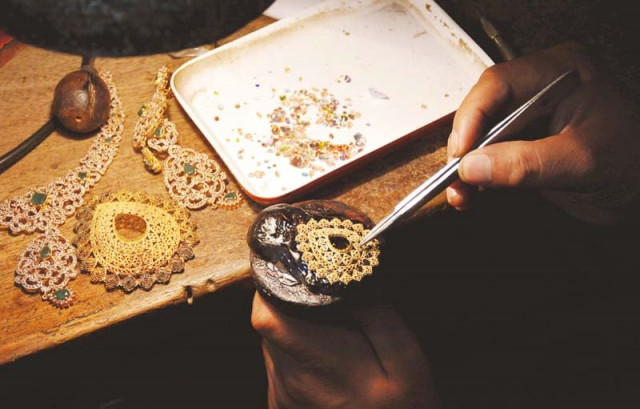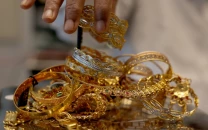Handmade jewellery: The golden formula
The fine art of handmade jewellery in Pakistan

Stones being set in a piece of jewellery. PHOTOS : HUMA CHOUDHARY
Steps
Making custom jewellery, however, requires time and fine craftsmanship. It’s an extensive process and certainly not as glamorous as the final product. Right from melting the gold in mud pots to setting stones to obtain the finished product, many intricate steps are required. “Whether it is 24-karat gold or 14-karat gold, the process of making custom jewellery is the same,” says Saeedur Rehman, a goldsmith running a small-scale manufacturing business in Raja Bazaar, Rawalpindi. He explains that every goldsmith starts with a carved wax model of the design after which a 24-karat bullion is mixed with alloys such as silver and copper to get the desired purity level.

Adding silver and bronze colour to the final product. PHOTOS : HUMA CHOUDHARY

Transferring the pieces on plaster of Paris. PHOTOS : HUMA CHOUDHARY
Workers need to be dexterous as the process involves minimal machine work. “We don’t have modern equipment or electricity,” says Tahir Ahmed, a craftsman at Rehman’s factory. Yet, these limitations have not hindered the creativity of Pakistani craftsmen and their products are in great demand in the international market as well. “Our designs and workmanship are appreciated by buyers all over the world,” adds Ahmed.

Hand-polishing the combined piece after it is removed from a plaster of Paris mould. PHOTOS : HUMA CHOUDHARY

Setting different components on a wax mould to give them a shape according to the design. PHOTOS : HUMA CHOUDHARY
1 Gold is melted and poured into containers to cool and harden.
2 Solid bars are then placed in a machine to make flat plates and wires. From these plates, thinner plates are cut as per the design, while wires are used to form hollow and solid balls.
3 All the pieces are placed in acid to make them shiny after which a sample piece for each component is made by hand. For example, if a necklace contains a flower pattern, then one flower from the design will be prepared first.
4 Using wax and heat, the sample is replicated (if required) and the rest of the pieces are made by pouring molten gold into a container that contains the wax mould.
5 Once all the different components are ready, they are set on a wax mould and given shape according to the design.
6 The pieces are then transferred on a plaster of Paris mould and joined using heat after which it is allowed to harden.
7 The ready product is removed from the mould and hand polished.
8 Stones are set into the design if required.
9 Silver and bronze colours are added to the final product as per each customer’s requirements.
Huma Choudhary is a photojournalist working for The Express Tribune in Islamabad.
Published in The Express Tribune, Sunday Magazine, July 19th, 2015.



















COMMENTS
Comments are moderated and generally will be posted if they are on-topic and not abusive.
For more information, please see our Comments FAQ